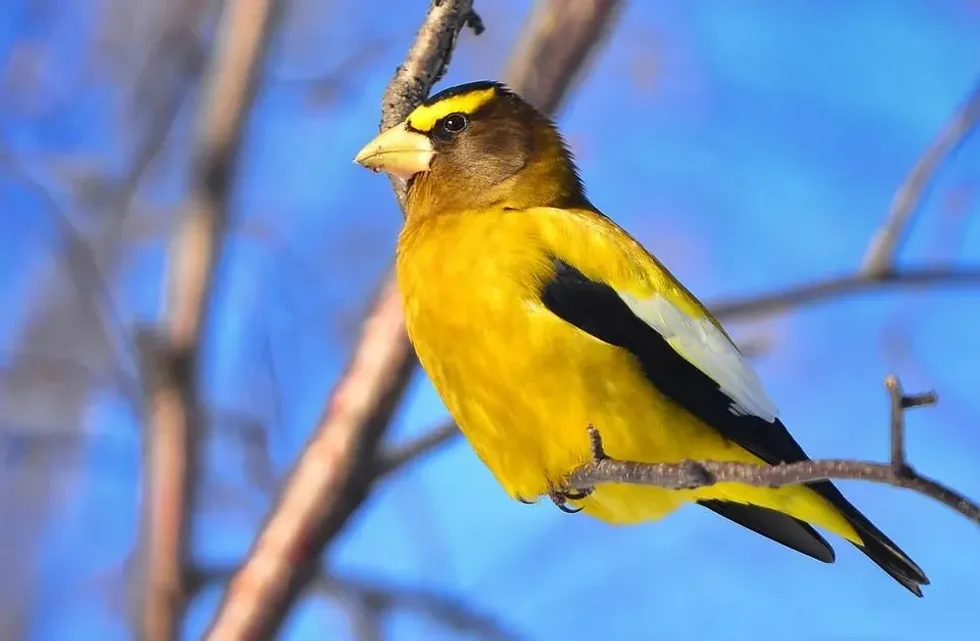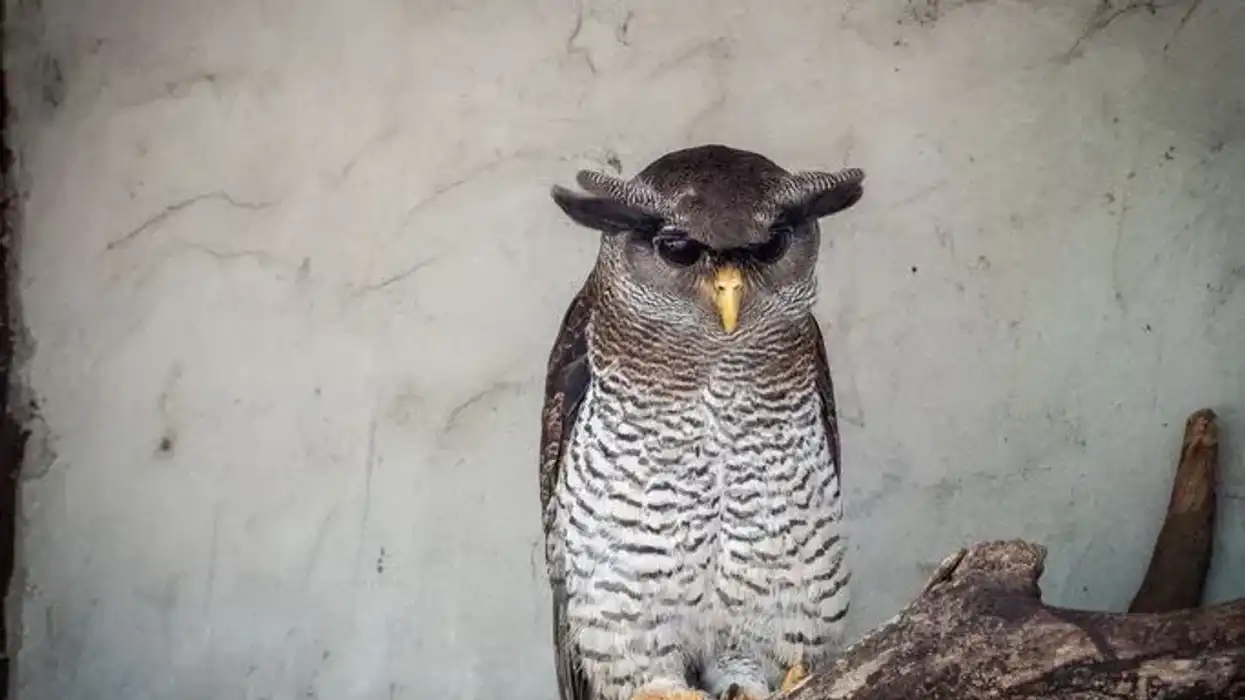The term 'Grosbeak' comes from the French word 'Gros-bec,' which means 'big beak.'
It got its name from the fact that it was believed to sing only at dusk when it was first discovered. Evening Grosbeaks are a small finch with a tiny head, a short, powerful conical bill with long wings, and a short tail.
During the winter, they travel in large flocks around suburban areas, searching for bird feeders and other resources, but once the breeding season arrives, they split into small groups or pairs.
Throughout the year, these birds are not aggressive to one another, but during the winter, territorial fighting may occur for food sources. These birds are less antagonistic during the breeding season.
These birds are featured on the cover page of the 2016 Partners in Flight Landbird Conservation Plan, as it has experienced the steepest population decline of 92% since 1970 in the continental United States and Canada.
After learning about the Evening Grosbeak facts, you might also be interested in reading about the blue grosbeak and the keel-billed toucan.
Evening Grosbeak Interesting Facts
What type of animal is an Evening Grosbeak?
The Evening Grosbeak (Coccothraustes vespertinus) is one among the 4000 species of Passerine bird or songbirds.
What class of animal does an Evening Grosbeak belong to?
The Evening Grosbeak belongs to the Aves class with stout conical bills and colorful plumage.
How many Evening Grosbeaks are there in the world?
As per The Cornell Lab Of Ornithology, there are 4.1 million breeding birds globally, with most of them habited in North America.
Where does an Evening Grosbeak live?
Evening Grosbeaks preferred breeding habitats in coniferous and mixed forests of Canada and western mountain regions of the United States and Mexico. They typically prefer to nest in higher-elevation trees and shrubs.
What is an Evening Grosbeak's habitat?
Evening Grosbeaks are found in the coniferous, as well as deciduous forest, but usually prefer to reside in the mountains. They build their nests on horizontal branches or in vertical forks of trees, often far from the trunk.
The height varies, but it is usually 20-60' above ground and can reach 10-100'.
Usually, females construct a cup-shaped nest from twigs lined with fine grass, moss, pine needles, and rootlets. They can also be a backyard feeder, but these North American birds generally nest in varied pine trees and large shrubs of their native.
Who do Evening Grosbeaks live with?
The Evening Grosbeak, like other similar species, is a social bird often found in flocks. These flocks provide protection and are less vulnerable to predators, especially when in migration.
How long does an Evening Grosbeak live?
These birds have been observed to live in the wild for up to 16 years.
How do they reproduce?
Evening Grosbeaks often form monogamous pairs. Their courtship is quiet and without song, but an adult male dances for the female by raising his head and tail, drooping and vibrating his wings, and swiveling back and forth.
Females and males alternately bow at each other is another courtship ritual. After mating, the female bird lays between zero and five eggs, which they hatch for about 12-14 days.
While the females are on the nest, the males feed them. After hatching, the nestlings remain in the nest for another 13-15 days.
Those birds will stay near their nests for another two to five days, being fed by their parents. It is not unique for a breeding pair to have two broods in a single breeding season.
What is their conservation status?
The global conservation status of these birds has recently changed from Least Concern to Vulnerable as their primary food sources are being harmed. These birds prey mostly spruce budworms; controlling spruce budworm has been a vital forestry goal with extensive pesticides as this worm is a parasite in many pulpwood forests and harms the trees.
They also found consuming budworm larvae and pupae. They also eat a lot of maples and, in particular, box elders' seeds.
In recent decades, forest management has prioritized fast-growing softwood trees for paper and wood products over slower-growing hardwoods like maple and box elder. Due to a decrease in their resources, the population of these species found declining.
Evening Grosbeak Fun Facts
What do Evening Grosbeaks look like?
Evening Grosbeaks are medium-sized songbirds. Male Evening Grosbeaks are more colorful than females, and they are sexually dimorphic. The adult male has dark brown heads, bright yellow bellies and backs, black wings with white wing patches, and short black tails.
They also have a bright-yellow stripe over the eye, similar to a headlamp. Female birds are primarily gray, with white-and-black wings and neck and flanks are slightly greenish-yellow. Adult males have a pale ivory bill, while females have a greenish-yellow bill.
How cute are they?
Evening grosbeaks with bright and colorful plumage are generally adored by bird watchers. With the Project Feeder Watch of Cornell Lab of Ornithology, you can watch and listen to these birds in nature.
How do they communicate?
These birds have a vocal organ called the syrinx, which can create a wide range of beautiful singing sounds. The Evening Grosbeak call is generally sharp, sweet, and burry screeches.
How big is an Evening Grosbeak?
The Evening Grosbeak body length ranges from 6.3-8.7 in (16-22 cm) and a wingspan of 12-14 in (30-36 cm). This bird is approximately the size of a Northern Cardinal, but more compact and thicker-bodied; smaller than a Steller's Jay or Blue Jay.
How fast can an Evening Grosbeak fly?
The Evening Grosbeak's flight speed is unknown; however, because they are similar in size, they may also fly at 20-36 mph like a Robin.
How much does an Evening Grosbeak weigh?
The weight of Evening Grosbeak ranges from 1.9-2.6 oz (53-74 g).
What are their male and female names of the species?
As there is no specific terminology to distinguish between a male and a female, they are commonly referred to as a male bird and a female bird.
What would you call a baby Evening Grosbeak?
Like other similar species, it is referred to as a nestling as it is not yet mature enough to care for itself. While the young bird develops most of its flight feathers, it is later referred to as a fledgling.
Afterward, it is referred to as a juvenile bird with passing most youth stages but still not a mature adult.
What do they eat?
In summer, Evening Grosbeaks mostly prey on insects like box elders, spruce budworm, and few invertebrates. During winter Evening Grosbeaks love to eat sunflower seeds and a wide range of seeds, berries, small fruits, and buds from trees and shrubs.
These North American birds are also found eating the buds of maple and drink maple sap by tearing off small maple twigs.
Their thick conical bill helps them to open and split seeds easily. You can attract these Evening Grosbeaks by putting some sunflower seeds in the feeder in winter.
Are they dangerous?
Evening Grosbeaks, like other birds, are generally highly intelligent and fun companions. They have no negative effects on humans.
Would they make a good pet?
Evening Grosbeaks, like other similar species, prefer to live in flocks. These birds make excellent companions since they enjoy playing, giggling, and eating with their owners.
Did you know...
Evening Grosbeaks eat a lot of spruce budworm. Many pulpwood forest stands are infected by this worm, which can be harmful to the trees. These birds are so good at spotting these tiny caterpillars that they are always the first to notice when a spruce budworm outbreak starts.
The Evening Grosbeak's call
Even though they are songbirds, Evening Grosbeaks do not sing. Only on rare occasions do they make quick, irregular warbles. The Evening Grosbeak song is usually shorter and whistled.
Flight calls are the primary communication calls used by these birds to maintain flock balance. Evening grosbeaks make a sound 'chee-er' in a simple tone that starts at a high frequency, gradually rises in pitch, and quickly descends. Other calls include sounds like 'tee-er', 'peeer', 'keeer', 'clee-ip', 'p-teeee', and 'p-teer'.
The Evening Grosbeak's migration process
Evening Grosbeaks migrate irregularly. These North American birds migrate in the fall and spend the winter far south when seed crops in Northern coniferous forests are low.
Migrations in the Eastern United States are observed to be in every two to three years, but they have become less common since 1980. For the winter, western subspecies migrate towards lower altitudes. If you find one in your backyard during the migration feed them with a variety of seeds or berries.
Here at Kidadl, we have carefully created lots of interesting family-friendly animal facts for everyone to discover! Learn more about some other birds including secretary bird, or common kingfisher.
You can even occupy yourself at home by drawing one on our evening grosbeak coloring pages.










